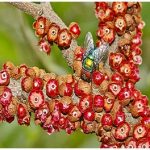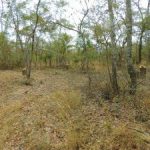TREE LIFE
July 2020
MASHONALAND BRANCH
This month we are still in lock down, we have no upcoming events, we have no news of fun outings, but hopefully the show will go on with the formal Chairman’s and Treasurer’s reports and the Minutes of our Cyber Annual General Meeting and, luckily, we have Ryan with news of some interesting tree and easy access to articles from previous editions of Tree Life which will bring back to mind items of interest. So, hopefully, there will be something of interest for those of you who read Tree Life.
-Mary Lovemore
CHAIRMAN’S REPORT 2019-2020 (70th AGM)
I have pleasure in presenting my fifth annual Chairman’s report of the Tree Society of Zimbabwe covering the year 1 April 2019 to 31 March 2020. This report is for the 70th AGM meaning we should be doing something special this year to commemorate the occasion, but with the present Covid-19 lockdown, it’s anybody’s guess as to what will transpire in the year ahead.
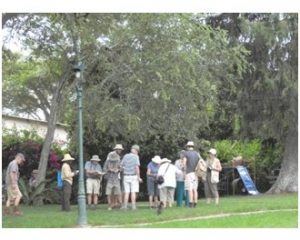
Serious discussions going on. photo from Jim Dryburgh
The regular Tree Society series of monthly outings continued and we managed to organise nine 3rd Sunday outings – the scheduled outing to Patrick Mavros was rained out. It has become increasingly more difficult to organise outings to private gardens for Saturday afternoons, thus we failed to have an afternoon outing a few times. With the fuel and economic situation being what it is, it was decided to cut down on the number of outings and now we will have either a 3rd Sunday morning or a 4th Saturday afternoon outing per month. The first month to be affected by this committee decision was March 2020. However, we will continue with our tree walks on the first Saturday of the month at the National Botanical Garden. The outings are summarized in the table below:
April 2019 : Sunday : Henry Hallam Dam Saturday: Chapungu Sculpture Park
May 2019: Sunday: AGM at Mukuvisi Woodland Saturday: Ballantyne Park Conservancy
June 2019: Sunday: Ewanrigg Botanical Gardens
July 2019: Sunday: Summer Island Farm, Goromonzi Saturday: Dandaro Retirement Village
August Sunday: St. Georges College Saturday: No outing
September Sunday: Lake Chivero Bird Sanctuary Saturday: Walk about in Alexander Park
October Sunday: National Botanic Garden Saturday: No outing
November Sunday: Henry Hallam Dam Saturday: Deon Theron home
December Sunday: Christmas Party at Bridgewaters Saturday : No outing
January Sunday: Christon Bank Saturday: Greenwood Park
February Sunday: Patrick Mavros (rained off) Saturday: No outing
March Sunday: Bushman’s Rock Saturday: No outing
April Covid-19 restrictions
Weekend Trips: As mentioned above, with the fuel and economic situation being what it is, we were unable to organize any weekend trips.
Tree Leaders: I would like to thank all those who have led in any of our many outings – Sunday mornings or Saturday mornings or afternoons. Without you, we wouldn’t have meaningful outings and I thank all those who “chip in” and make the outings special
Tree Life: Mary is now the editor of Tree Life and doing a wonderful job. Sufficient material is not always available as there appears to be a reluctance to send in articles – this results in some rather “thin” Tree Lifes with very few pages. Occasionally we have to resort, on only one occasion, to having a Tree Life covering two months! Fortunately, Mary has been able to keep coming up with interesting material from past newsletters and other sources to “beef up” Tree Life.
Thanks to those who contributed write-ups on our outings and articles for Tree Life – in order of appearance Ryan Truscott, Jan van Bel, Tony Alegria, Mary Lovemore, Ann Sinclair, Isla Grundy, Dawn Siemers, Lyn Mullin (Sept. 2001), Mark Hyde, Thora Hartley, Rob Pare (Nov. 1992), Mr. G. H. Tanser (Sept. 1968), George Hall (Jan. 1975), Rob Burrett (Aug. 1992), Kim Damstra and two unknown authors from the earlier newsletters. Apologies to anyone I may have left out. For the last year I feel that Ryan Truscott, Ann Sinclair and Jan van Bel have made the most contributions – many thanks.
Bequest: In early November 2016, we were asked by Jono Waters to manage a bequest by the late Mrs. Lottie Gyde for the National Botanical Garden. Most of this money was spent on the water system and on tree labelling. There’s a tiny bit left which will now go nowhere!
Finances: The financial position of the Society remains satisfactory. The accounts and balance sheet were prepared by Bill Clarke and emailed to all members. Bill looked at the society’s needs and set the annual subscriptions to what they are now – anyone paying later on will probably pay more as the subs. will be adjusted as needed depending on inflation.
Tree Society Facebook group: Since last year the group membership has increased by another 330 and stood at 3571 as at 10th May. From the Facebook page we point to the website and vice versa.
Tree Society Website: Mary captured all the back numbers of Tree Life and whatever newsletters were available from the early days when we were the Tree Society of Rhodesia. All this vast amount of information has now been uploaded to the web site. This was a mammoth task and I thank Mary for the many hours she has devoted to completing this exercise. During the last year, 10th May 2019 till 10th May 2020, there have been 7308 hits on the website with 946 in the last month alone. The top ten countries for the last year are listed and as expected the majority of hits came from Zimbabwe with 3556 followed by: USA 938; South Africa 702; UK 479; Australia 241; India 143; Nigeria 116; Canada 76; Germany 75 and Zambia 49.
During the year, besides getting all the Newsletters totally up to date, quite a few pages have been added to boost the website. Most of this material was supplied by Mary from past newsletters and other sources – once again, thanks Mary. The committee discussed the issues with creating another gallery for the website entitled Spectacular Trees. To get more thoughts / ideas on the matter, in the last Tree Life I asked all members for suggestions on what should constitute a spectacular tree and ideas for the new gallery. Unfortunately I have not heard from anyone at all. How come?
Herbarium fumigation: Fumigation of the National Herbarium was carried out only once last year by Fumigation Services and we are overdue for the next fumigation exercise – the economic situation and Covid-19 can be blamed for this!
Tree Labelling: Not much work was done on this project in the last year mainly due to the economic and fuel situation. However, the National Botanical Garden pamphlet was finalized and emailed to all members. It is now being sold at the entrance to the garden.
Christmas Party: Unfortunately due to the drought, we were unable to go to Val d’Or for the Christmas Social in December last year. I thank Jim and Ann Sinclair for making Bridgewaters complex available to us for this annual social function. Sadly, only ten of us turned up for the occasion.
After enjoying some refreshment and Christmas fare, it was time for some fun. Ann had organized a scavenger hunt and two teams set off to get a bit of the tree which would be diagnostic. Both teams failed to get all the samples but had a lot of fun and enjoyed some camaraderie in trying to do so. After lunch we were treated to a fun quiz organized and run by Bill Clarke. It was a really good day! Those who missed it, missed out!
I feel that there is so much going on by all the Clubs/Societies at this time of the year that we should perhaps have our Christmas / Social Party at some other time of the year when not much is going on. Perhaps then, we could get many more members participating.
Membership: As at 31 December 2019, we had 108 members, comprising ordinary, external and honorary members.
Committee: Since the last AGM, there have been no changes. The current committee consists of the following nine people: Jim & Ann Sinclair, Isla Grundy, Bill Clarke, Teig Howson, Ryan Truscott, Mary Lovemore, Jan van Bel and myself. My sincere thanks go to the members of the Committee for their hard work and support. A big thank you to Mary, once again she has done the most work in the past year for the Society.
In conclusion …
Finances have been a challenge this year and membership numbers are up by one. Unfortunately with the Covid-19 lockdown no outings are presently taking place but we’ll carry on regardless with Tree Life and other information until such time as we can meet again.
-Tony Alegria Chairman
MINUTES OF THE 70th ANNUAL GENERAL MEETING OF THE TREE SOCIETY OF ZIMBABWE HELD ON 16th MAY 2020 BY EMAIL
PRESENT : Because the AGM was conducted by email, all members (including External members) were deemed to be present.
NOTICE CONVENING THE MEETING: The notice convening the meeting was also sent by email on 16th May.
APOLOGIES : As this AGM was conducted by email, there was no venue to be at by a certain time on a particular day, therefore apologies were not necessary. All members could participate.
MINUTES OF THE 69th A.G.M. had been circulated by e-mail to all members.
MATTERS ARISING FROM THE 69th AGM MINUTES – None.
CHAIRMAN’S REPORT – The Chairman’s report for the year ended 31st March 2020 was emailed to all members. Proposed by Bill Clarke and seconded by Ryan Truscott.
TREASURER’S REPORT – The Treasurer’s report for the year ended 31st March 2020 was emailed to all members. Proposed by Ryan Truscott and seconded by Tony Alegria.
ELECTION OF OFFICERS
Isla Grundy stood down and the rest of the old committee became the new committee. Nobody volunteered to join the committee. The incoming committee members are now: Ann & Jim Sinclair, Bill Clarke, Jan van Bel, Mary Lovemore, Ryan Truscott, Teig Howson and myself.
ANY OTHER BUSINESS –
8.1 Mary Lovemore commented : At this Cyber AGM, life is very different, is it not?
I would like to give thanks to our Chairman for holding us together in his casual, cheerful manner, and for all the work he has done for all the community of folk interested in trees and tree names with tree labelling. This has been a long and costly, in time and fuel, contribution. Here I must also mention all the enthusiastic help he has received from Jan van Bel and Chris Chapano, and of course, Mark Hyde and Meg Coates Palgrave when they are on the Tree Walks in the Gardens. This has been a great contribution, thank you Tony, and the rest of the gang.
The 70th AGM is now concluded.
The following article appeared in Tree Life 34, December 1982 and was written by Paul and Meg Coates Palgrave based on thoughts by Trevor Gordon. It is a delightful read, and can you not just hear Meg and Trevor as you read? “look with your eyes, pick a leaf!’
Mary.
NATURE INTERTWINED
The identification of trees and plants is no easy matter for the layman. However, if a real interest is taken and keen observations made the task becomes easier and infinitely more interesting. Habitats, such as granite kopjes, river banks or open woodland; seasonal variations such as spring or autumn leaf colours, as well as the times of flowering (for instance our Proteas and the two commonest Cassias can easily be identified by the time at which they flower); altitude can often be critical and the general shape or field impression of the tree, often scorned by the botanist who has long passed that stage, but so helpful to the beginner.
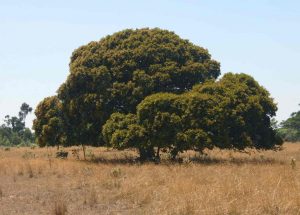
Parinari curatellifolia. Photo: Bart Wursten. Source: Flora of Zimbabwe
One of the most beautifully shaped trees is the Mabola Plum, Parinari curatellifolia, it always seems to have been pruned to a perfect toadstool shape and, in contrast, the Muwanga, Pericopsis angolensis, with crooked pearly stems that, no matter how much they bend and twist, always end with the leaf canopy in perfect symmetry.
Examination of the bark is not only very helpful but in many cases can be completely characteristic; the delicately coloured peeling bark of Ochna pulchra (pulchra means beautiful); the malaria yellow bark of the Fever Tree Acacia xanthophloea; the bark of Commiphora marlothii and Albizia tanganyicensis peeling in sheets of yellow and red paper respectively and the rainbow colours of the bark of Sterculia africana.
Closer examination can be even more rewarding. Little tips can be found that will always be recognizable in the future. For instance a 1mm diameter pale gland found at the junction of the leaf stalk and the blade of the leaf tells immediately that this is a species of Monotes. This little gland is an extra floral nectary which only means that a nectar producing organ for some reason is not in the flower but on a leaf. It has been seen to exude its nectar which dribbles down the leaf stalks and is eagerly sought by ants.
Talking of ants, many insects can be a great help with identification. Butterflies are very particular in choosing the right food plant for their caterpillars and land briefly on one leaf after another tasting them with the taste buds on their feet, then leaving that tree to taste the next, repeating the performance until the right one is found. Then and only then will they lay their eggs. This ‘tasting flight’ is quite characteristic and recognizable and when finally the egg is laid the plant is identified. No not quite, actually, as each female butterfly has a short list of plants she will accept, but it narrows down the field a great deal. To illustrate the point, the Swallowtail butterflies favour members of the Citrus family RUTACEAE but each species of Swallowtail uses only a few members of that family as food plants; for instance, in the Murahwa’s Hill area at Mutare the Mocker Swallowtail lays almost exclusively on Teclea nobilis and the Emperor Swallowtail on Fagaropsis angolensis while the Citrus Swallowtail is so called for its prevalence, to the extent of becoming a pest, on Citrus trees.
Recently at Matopos our attention was attracted to a tree by the fact that Citrus and Green-banded Swallowtails were laying on its leaves. As we immediately suspected it proved to be the Cape Chestnut Calodendrum capense and as an added bonus it was in full flower.
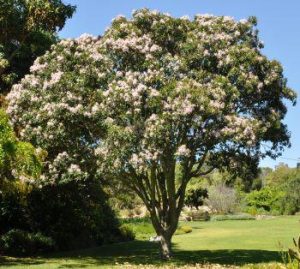
Calodendrum capensis. Photo: PlantzAfrica
Moths are usually haphazard layers. Everyone must have seen moth eggs laid on walls and windows or anywhere, laid close together in a bunch, whereas butterflies usually lay them singly dotted around the leaves. Not, however, the moth of the gregarious caterpillar Diapalpus congreganius which meticulously chooses Cassia leaves for its young to eat, almost exclusively Cassia singueana, Winter Cassia. (Mr Trevor Gordon records finding only one on a Cassia abbreviata, long tail Cassia). The caterpillars build an untidy drooping nest of spider like web in which to spin their cocoons. Even after they have long since hatched and flown away this nest remains as a label with Cassia long since hatched and flown away, this nest remains as a label with Cassia singueana written on it.
Take a moment now to think also that to an entomologist studying butterflies, a nest of cocoons found on a Cassia tree is a label with Diapalpus congregarius written on it. Consider, too, that this entomologist finding caterpillars on a Cape Chestnut would immediately look up Swallowtails in his book. This is how closely all sections of nature are intertwined.
Parasitic wasps of the Braconid species are highly selective in the caterpillars (and other insects) that they parasitize. Their ovipositors, egg-laying tubes, puncture the victim’s body and they lay their egg deep inside. They hatch and feed on the flesh around them (being careful not to destroy any vital organs) until they mature, when they bore their way out of the body and weave their cocoons outside. An examination of the cocoons on the back of a caterpillar will certainly identify both caterpillar and wasp.
Here, of course, we come into the fascinating area of biological control where the prickly-pear plague of South Africa was eliminated by an insect and the rabbit plague of Australia was controlled by a virus. A dangerous science where the beneficial predator can so easily become a pest in itself but, properly controlled, very full of potential.
Many plants display galls which, our scientific dictionary says, are excrescences caused by fungi, mites or insects. With some tree species the presence of galls is so characteristic as to give the clue needed to make an identification. The sight of a Silver Terminalia in stark winter leaflessness but covered in galls is quite unmistakable; the pods of Xeroderris stuhlmannii can be so attacked that the tree seems to be covered in berries, which is most misleading until the discovery of one pod reveals the secret, and the infection of the flowers or fruits of the Water Berries to form the distinctive tangled black masses which so easily identify the trees.
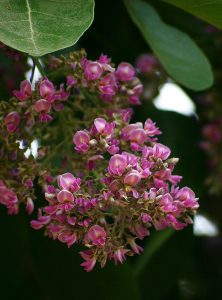
Lonchocarpus capassa, Photo: Bart Wursten. Source: Flora of Zimbabwe
Look around you and note everything. The swift flashing flight of the beautifully Charaxes butterflies to a ‘sucking tree’ which is exuding a sap which they enjoy; a tree raining water to form pools beneath it in the hottest driest month of the year means the presence of a frog-hopper insect infesting the tree sucking its sap so voraciously that it is running in froth out of its body. This could almost certainly be the Rain Tree, Lonchocarpus capassa, but there are a few other species that it could be and the insect would be Ptyelus grossus. As a protection against the heat it covers its back with this froth, commonly called cuckoo spit in other closely related species; birds clustering in a tree will draw attention to edible fruit or nectar filled flowers; a browsing giraffe prefers Boscia and Acacia species and a Square lipped Rhinoceros eats mainly the perennial varieties of grass.
Heavy metals such as nickel, chrome, copper and arsenic are extremely toxic to plants. This is why parts of the hills of the Great Dyke are so characteristically bare of trees and close examination will show that the grass is a species tolerant to the heavy metals. On the Wedza Mountains there are the ‘nickel anomaly’ areas where the concentration is such that only 17 species of grasses, herbs and trees has been found. One wooly herb, Dicoma macrocephala seems only to grow on nickel bearing soils and has thus earned the name Nickel Flower, similarly Becium homblei is the Copper Flower and, even more specifically, certain groupings of species give a more accurate indication of certain metals.
The potential of the vegetation being a guide to locating economically important minerals has been recognized for a long time, but it is only fairly recently that the matter has been treated seriously. It can be divided into two sections 1) Geobotany which is the recognition of the indicator species and the tolerant ones which strongly suggest the presence of the metals; and 2) Biogeochemistry which is the chemical analysis of certain parts of the plants to find out the concentration of the metal in the soil. Research is making this study more exact all the time.
Disturbed ground around the foot of a tree immediately raises the question why? Are the roots edible to man or animal or have they been sought after by a medicine man for his potions? Bark stripped from a tree raises the same questions and one should always notice everything and question everything. One cannot study just one facet of nature; all the other facets keep on getting in the way. But the more they get in the way the more one realizes how fascinating nature can be.
-Paul and Meg Coates Palgrave
TREE OF THE MONTH: THE SHAGGY-LEAVED ‘SKY DUSTER’ Washingtonia robusta
Our tree of the month is an exotic that has helped to facilitate the spread of a rather endearing Zimbabwean bird.
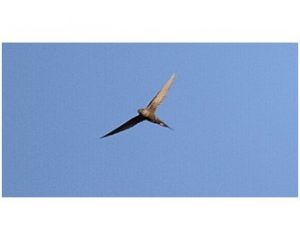
An African palm-swift on the wing Pic. Dominic Sherony Wikimedia Commons
The tree is the Washingtonia palm, Washingtonia robusta, a species that originated in Mexico’s arid Sonora state, but is now cultivated across the globe.
We have two scruffy specimens growing outside our front door in Mount Pleasant. They occasionally shed whole dead leaves, more than a metre long, which fall onto the roof with a terrifying crash.
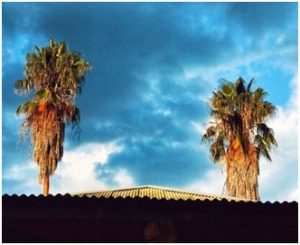
The Washingtonia palms outside our front door Photo – Kate Truscott
But the trees do have at least one redeeming feature: they play host to squadrons of African palm-swifts, Cypsiurus parvus.
In fact, wherever there are Washingtonia palms in this country, there seem to be palm-swifts, racing through the sky with high-pitched chittering calls.
As a boy growing up in Mutare, I used to watch flocks of them as I sat on the low wall outside the Rainbow Cinema along Robert Mugabe Road, waiting for a ride home. The cinema is now closed, turned into a High Court, and the Washingtonia palms that once stood there are no more.
But when left to grow, the trees can reach up to 30 metres in height. Not surprising that residents of Los Angeles have come up with an enchanting nickname for them: Sky Dusters. The fan-shaped leaves clustered at the top of long skinny trunks do resemble feather dusters brushing the blue skies of California, or Zimbabwe.
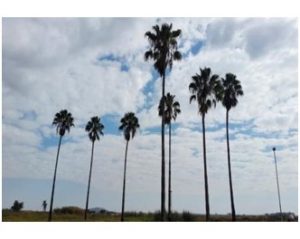
Sky Dusters’ brushing the winter sky in Marlborough, Harare Photo Ryan Truscott
I’m not sure when our two palms in Mount Pleasant were planted, but they are not yet Sky Dusters. The ones that do deserve that rank, however, are the famous ones that grow along Julius Nyerere Way in central Harare.
The late LJ Mullin, in his book Historic Trees of Zimbabwe, said the trees were planted back in the 1920s. By 1987, he said, there were still 50 Washingtonias growing along the stretch between Samora Machel and Nelson Mandela Avenue, out of an original 70.
Washingtonias can live for more than 500 years, we’re told, which is good news for the palm-swifts. These birds lay their eggs on the back of Washingtonia palm leaves, gluing the nest and eggs in place with saliva.
Before planting exotic palms like Washingtonias became a trend here, the palm-swifts were confined to low-lying regions, below 900 metres, where Zimbabwe’s indigenous palms are known to grow, like the two Ilala species, Hyphaene natalensis and H. benguellensis.
The planting of exotic palms above 1,200 metres has meant the birds have expanded their range to places like Harare. But it sometimes comes at a great cost.
A few years ago a friend of mine noticed several dead palm-swifts lying around his farm yard near Mutare. He asked me if I knew why they’d died. I didn’t. But in April, I finally discovered the answer. It was on Palm Sunday as it happens.
I had been watching the palm-swifts streaking around our Washingtonias that evening, their scimitar-shaped wings and pencil-sharp tails silhouetted against clouds tinged pink and orange by the dying day. Inspired, I decided to quickly do some research for my daily bird story to share with the family at the dinner table.
I consulted Birds of Zimbabwe, by the late MPS Irwin, and learnt that having high-altitude palms, especially Washingtonias, has meant the swifts are subject to harsher winters than would ordinarily occur in their traditional low-lying range.
Large numbers of young birds occasionally succumb, and are found dead beneath their roosting places, like the ones I saw in my friend’s farmyard all those years ago.
Irwin noted that the impact of this on the overall palm-swift population in Zimbabwe was only temporary. But that was back in the 1980s. Forty years on it may be time to check if that is still the case.
We need our children and their children to still take delight in watching them slice through the air, chittering to each other as they make their homes beneath the shaggy leaves of the towering Sky Dusters.
-Ryan Truscott
I was most excited to find these two excellent articles on the Kalahari sands – such an exciting part of our country. The first, a Rootnote Kim Damstra is reporting on John Rushworth’s work in Hwange National Park and appeared in Tree Life 47, January 1984, and the second is part of the report on the Tree Society’s visit to the Victoria Falls and Kim, again, comments on the vegetation on Kalahari sand, as only Kim can report! It appeared in Tree Life 124, June 1990
Mary
ROOTNOTE
John Rushworth of the Department of Biological Sciences at the University of Zimbabwe displayed some results recently that I thought bear repeating. He has been working in the Kalahari Sands of Hwange National Park. “Large areas of deep, infertile Kalahari sand in Western Zimbabwe are carpeted with a dense woody shrub community one to four meters tall, and are often regarded as of little use to man or the larger herbivores”. In fact only about 2% is silt and clay. A rich soil of volcanic origin also within the National Park is known as a basalt vertisol and contains 91% silt and clay. This difference is important because many nutrients that are washed away in sand will cling onto the tiny clay particles and therefore will be available to the plants.
To sidetrack for a while this is one reason why termitaria are often so rich in nutrients. The termites collect all the clay and silt from the surrounding area and pack it into their nest.
This helps change the nutrient status so dramatically that we cannot fail to notice the differences between vegetation on the termitarium and off it. To get back to the Kalahari Sands they do have a low level of nutrients. But coarse sand does have an advantage. Kalaharis usually use a high proportion of sand in seed trays to encourage rooting. Kalahari Sand is an excellent rooting medium. Many trees develop an extensive root system in the 30 m deep sands. The rain water is quickly absorbed into the sand where it is available to the roots. Many of the trees are legumes such as Baphia massaiensis, Acacia fleckii and the teak Baikiaea plurijuga and can increase the nutrient status be means of nitrogen fixing bacteria in their roots. Other Kalahari plants besides these can also fix nitrogen.
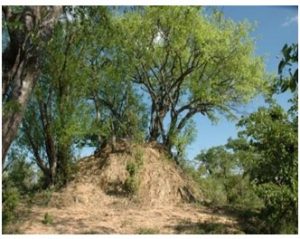
Termite mound with Commiphora molle (green trees on right). Photo by Dave Cumming
Dr. Rushworth investigated the availability of food to animals during various parts of the year, especially by comparing grasses and woody shrubs. He found that at the height of the dry season, before the rain, the deep rooted trees flushed out in new growth which had a moisture content of 68% compared to the grass water content of 20%. There was also much more browse available. The crude protein of the perennial grasses at this time of the year ranged from 4 to 6% whereas in the shrubs it ranged from 19 to 26% – rather significant. The one exception was Lonchocarpus nelsii which had 39% crude protein in the leaves in September. “Of the plants listed Terminalia sericea and Baikiaea plurijuga, teak, are not as favoured by the wild herbivore browsers, including elephant giraffe, eland, kudu, impala, steenbok and duiker, as the remaining species, Baphia massaiensis, Bauhinia petersiana subsp..serape, Combretum collinum, Pterocarpus angolensis C. zeyheri, Lonchocarpus nelsii and Ochna pulchra. Bearing in mind the high quality of this leaf material, a good stock of valuable food is available in this shrub community particularly during the dry August to November period when the grass layer is both low in quality and quantity”. John goes on to conclude : “The high quality of woody shrub leaf material produced under arid conditions on infertile Kalahari Sands in Western Zimbabwe is nothing short of remarkable. Many wild herbivores, particularly the browsers, thrive on this source of high quality food available in large areas of the Kalahari sand region of Hwange National Park. Provision of permanent water supplies is often the only management aid required.
It is apparent that there are vast untapped stores of valuable food available in the leaves of many woody shrubs of the ‘bushy/scrubby’ areas of Zimbabwe for both domestic and wild herbivores. Simple management practices can make much of this food energy available, particularly during the critical dry August to November period when natural grass stocks are low in both bulk and quality. The discovery that two apparently ‘useless grazing grasses’ Eragrostis spp. play a role in vital atmospheric nitrogen fixation must surely make one more hesitant in the future to arbitrarily proclaim that any particular plant is of no use. We often know so very little about the life histories and real value of our indigenous plants. The woody species of the Kalahari sand shrub community appear to represent equilibrium species, expending energy in the building up of massive underground rootstocks or other storage organs which give them the advantage in long term survival. This particular ecosystem is remarkably resilient to above ground damage and it represents both a very stable and valuable resource”.
Quotations from Rushworth, J. E., 1978, Wankie National Park Notes No. 20, 8pp.
-Kim ST.J.Damstra
WILLIAM TELL’S BUTTOCK AND KALAHARI SAND
Last night I dreamt I went to the Falls. The colonial grandeur of the Falls Hotel is impressive in a dream with its spectacular view of the continuous mists that rise from the falls and fall on the rain forest. The mist also falls onto the bridge that spans the second gorge, raining onto the passing railway carriages, just as Rhodes had dreamt it would do. But this dream was more real than Rhodes’ dream, partly because he died before the bridge was built but most because he never bothered to visit the falls. (subconscious dreams awaken the nurtured prejudices absorbed from my ouma –grootjie, she showed as much respect for Rhodes as my boerbul shows towards newly planted ranunculus tubers at $5 a dozen). In fact this dream was more than just real, it was surreal and there on the steps was Salvador himself, entranced by the landscape. I turned to see what it was he was expecting to find one of Gala’s eyes framed by the arch of the bridge? But no, his attention was focussed on the trees. Yes these trees do attain a super reality, they are truly surreal. The musasas dwarf any found around Harare. I felt I needed to explain about the thick layer of basalt into which the Zambezi had cut its steep sided gorges. Maybe he did not know that this basalt was part of a huge sheet of larva that once stretched from coast to coast and all the way to Lesotho. Today it stretches at least as far as Bulawayo. That was a bare and hostile period in our history. Then came the great sand storms that blew in tons of dry Kalahari sand, these covered the solidified larva. Did Dali know that rain water drained through the coarse sand and formed a reservoir along the basalt? Could he see that these trees had their roots in this reservoir. That explained their size. Even in a dream it is all quite logical. But as I looked Dali left the steps and made his way to one of the tables laid with tea. Here the Guibourtia coleosperma provided dense shade. The two dark green leaflets on each leaf blew gently in the breeze. A magnificent specimen with a huge horizontal branch that was propped up with a crutch. Another crutch held up the musasa that shades the lunch time marimba band. And all at once I saw the smile on Dali’s face – the crutches! Crutches and Dali. Crutches that support William Tell’s buttock, crutches that prop up ‘sleep’. We were in a surreal landscape and all because the trees on Kalahari Sand had roots that reached the basalt. Then the dream stopped. I was left alone to discuss the vegetation on the Kalahari Sands at Victoria Falls
The rain forest is on basalt. Remember that before the present gorge was formed the broad Zambezi flowed over this area and fell into what is now the second gorge. But as soon as you cross the railway line on the path to the Falls Hotel, the basalt is covered with coarse Kalahari Sand. The bare sand heats in the sun so that Jessica and Jemina were seen running from shade to shade. The shade is provided by Baphia massaiensis sub. obovata which were covered in the distinctive Baphia pods. We found a late flowering specimen in the camp site, it was densely covered in cascades of white pea like flowers. None of the specimens we saw was the coral pink colour of Tom’s Baphia in the gardens.
Baikiaea plurijuga (the Zimbabwean teak) is also common on the sands. The few specimens still had a few of the large purple flowers, but the main season was over. These would make superb garden trees except for the fact that they struggle to grow off Kalahari Sand. Tom only succeeded when he imported truckloads of Kalahari sand. Their wood is highly prized for timber. So is the wood of Guibourtia coleosperma but apparently in this case it is the burls (knots) that are sought out. Fanshaw says that most of the trees with burls have been cut out.
On the path from the Falls Hotel to Makasa Sun we met up with 30 banded mongooses scampering across the lawn. This may be the same group that we saw feeding in the rain forest. Their path led them past a strange Diospyros with bunches of sweetly scented white flowers clustered on the old wood. This is Diospyros batocana which has a very limited distribution in Zimbabwe, only creeping into this far off corner.
Not far off is a tall Erythrophleum africanum with alternate leaflets on the bi-compound leaves. A handsome tree with delicate foliage.
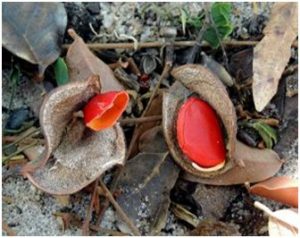
Guibourtia coleosperma seeds Photo: V.Williams. Source: Flora of Zimbabwe
On the way back to the campsite we saw two enormous Acacia albida between the Post Office and the Railway Line. These were in new grey green leaf and with spikes of cream flowers. Around the campsite there is also a wealth of species on the Kalahari Sand. Ricinodendron rautanenii which resembles a baobab and has balsa light wood. And who could forget a tree called Amblygonocarpus andongensis, I had only ever seen this species in the Botanic Gardens. Ficus salicifolia (now F. cordata) and Gyrocarpus americanus grow near the offices along with baobabs in fruit. The huge Schrebera trichoclada reminds us once again of Dali who invented the term Cladelism after his fictitious character Solange de Cleda. Cledalism relates to sadism and masochism but refers to pleasure and pain sublimated in an all transcending identification with an object, rather an exciting sensation that may well relate to the sensuous trunks of Ochna pulchra that here attain a size unprecedented around Harare. Yes, there is a lot more to the Falls than curtains of water.
-Kim Damstra
TONY ALEGRIA CHAIRMAN


